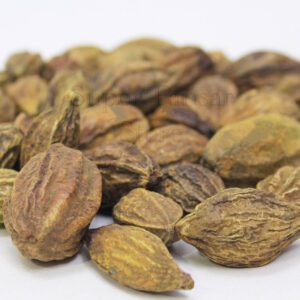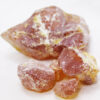₨ 150 – ₨ 1,400Price range: ₨ 150 through ₨ 1,400
Overview
Gum rosin, also known as colophony, is a natural resin derived from pine trees, particularly from the resinous sap or oleoresin of pine species such as Pinus taeda and Pinus elliottii.
It is obtained through a process called tapping, which involves making incisions in the bark of pine trees to collect the resin.Gum rosin is typically transparent to translucent in appearance, with a glassy texture when solidified.
It ranges in color from pale yellow to amber, depending on the source and processing method.
It is brittle at room temperature but becomes soft and tacky when heated.
Gum rosin is primarily composed of a mixture of resin acids, including abietic acid, pimaric acid, and isomers of these acids.
It also contains small amounts of volatile oils, terpenes, and other organic compounds.
Uses
Gum rosin, also known as colophony, is a versatile natural resin with a wide range of industrial applications.
Here are some of the common uses of gum rosin:
Adhesives:
Gum rosin is a key ingredient in the formulation of various adhesives and glues.
It provides tackiness and adhesive strength in products such as hot melt adhesives, pressure-sensitive adhesives (e.g., tapes and labels), woodworking adhesives, and shoe adhesives.
Printing Inks:
In the printing industry, gum rosin is used in the production of printing inks, particularly in offset printing.
It helps improve ink viscosity, adhesion to the printing substrate, and drying properties.
Gum rosin-based inks are widely used in newspapers, magazines, packaging materials, and commercial printing.
Paints and Coatings:
Gum rosin serves as a binder and film-forming agent in oil-based paints, varnishes, and lacquers.
It enhances the gloss, durability, and adhesion of coatings on various surfaces, including wood, metal, and concrete.
Gum rosin-based paints are commonly used in architectural coatings, industrial coatings, automotive finishes, and marine coatings.
Rubber and Tire Industry:
Gum rosin is added to rubber compounds as a tackifier and reinforcing agent.
It improves the adhesion between rubber components and enhances the mechanical properties of rubber products, including tires, rubber belts, conveyor belts, footwear, and automotive parts.
Soaps and Detergents:
Gum rosin is used in the production of soaps and detergents as a stabilizer, emulsifier, and thickening agent.
It helps improve the lathering, cleansing, and foaming properties of soap products, including bar soaps, liquid soaps, laundry detergents, and dishwashing detergents.
Soldering Flux:
In electronics manufacturing, gum rosin is a key ingredient in soldering flux formulations.
It facilitates the flow of solder and removes oxides from metal surfaces during soldering operations.
Gum rosin-based fluxes are used in soldering electronic components, printed circuit boards, and electrical connections.
Paper Sizing:
Gum rosin is used in paper manufacturing as a sizing agent to improve the strength, smoothness, and printability of paper and paperboard products.
It helps control the absorption and penetration of ink, improving the quality of printed materials and reducing ink bleed.
Cosmetics and Personal Care Products:
Gum rosin is utilized in some cosmetic and personal care products as a thickening agent, stabilizer, and emulsifier.
It helps improve the texture, consistency, and stability of formulations such as creams, lotions, hair styling products, and lip balms.















